Preventive Dentistry in Phoenix, AZ

You’ve no doubt heard it said that an ounce of prevention is worth a pound of cure. In dentistry, you might say it’s worth two pounds. Maybe even thousands of dollars. That’s because dental problems can become exponentially more expensive — and painful — the longer they go unaddressed. Fortunately, modern dentistry has many easy and relatively inexpensive ways to make sure that today’s minor annoyance does not turn into tomorrow’s major headache.
Preventive dentistry describes all the procedures used to arrest tooth decay and other diseases in the earliest stages. The goal is to keep you as healthy as possible and maintain your natural teeth for life.

Even if you brush and floss your teeth faithfully, it is important that you have your teeth professionally cleaned on a regular basis. (Of course, if you aren’t quite so meticulous about your oral hygiene, it’s even more important!) After a thorough cleaning, your teeth will feel smooth and squeaky-clean, and they will probably look a lot brighter too. But professional teeth cleanings aren’t done for looks alone.
Why do your teeth need this kind of attention? Essentially, it’s because over time they tend to build up a layer of plaque (a sticky, bacteria-rich film) and hard deposits (called tartar, or calculus) that are very difficult to remove without special tools. When these deposits are allowed to remain on the tooth surfaces or below the gum line, they provide ideal conditions for bacteria to grow and multiply. The acids produced by some bacteria cause tooth decay and gum disease; if left uncontrolled, this can lead to inflammation and infection of the gums, and possibly influence systemic (whole body) diseases.
Dentists have a special term for preventive procedures like tooth cleaning: prophylaxis, from the Greek word meaning to protect or guard against. In this case, the focus is on preventing tooth decay and gum disease. Performed in conjunction with a routine dental examination, a professional cleaning can go a long way toward controlling these two common maladies. While your teeth are being cleaned, it’s also a good opportunity to take a close look at your oral health in general and check for a few specific problems.
The professional cleaning procedure
Teeth cleaning is often performed by a dental hygienist — a highly trained technician who uses a special set of tools designed just for this purpose. Because everyone’s teeth are a little different, your cleaning will be tailored to your particular needs. However, many cleanings follow a similar pattern.
First, the dental hygienist will do an oral examination to evaluate the health of your oral tissues. Then the cleaning will take place using either an ultrasonic scaler or metal instruments referred to as curettes to remove the plaque and calculus from the tooth surfaces. The ultrasonic scaler is a hand-held tool with a tiny tip that vibrates at a very high frequency. Hardened deposits are broken up by the rapid movement of the tip, which does not damage the tooth. A constant stream of liquid (called lavage) serves to cool the tip and aid in plaque removal; at the same time, it also washes away the debris.
Some hygienists prefer curettes, which are hand-held instruments that are curved and tapered to fit around and in between the teeth. If your teeth are sensitive, using hand-held instruments may be more comfortable for a professional cleaning. In the capable hands of a hygienist or dentist, it takes only moderate pressure to remove any stubborn buildup and scrub the teeth clean, regardless of which instruments are used.
Finally, your teeth are polished with a low-speed rotary brush fitted with a soft rubber tip. A slightly gritty, toothpaste-like gel is applied, and the tip spins around and polishes the teeth, making them smooth and shiny.
A requirement for good oral health
Most people don’t feel any noticeable discomfort during dental cleanings; some even report they enjoy the experience — especially the dramatic results when it’s done! If you haven’t had a cleaning in a while, however, it may take you a few moments to get used to getting your teeth cleaned. If you experience any discomfort, however, it may be possible to apply a topical numbing gel or another type of anesthetic.
If your gums are irritated due to bacterial buildup, they may become sore or bleed slightly during the cleaning. It may be possible to prevent this from occuring in the future with oral hygiene measures you can perform at home (such as improved flossing techniques or special mouthrinses); it might also indicate that you need more frequent in-office cleanings. This type of regular maintenance will help you avoid more involved dental procedures down the road — and it will give you the best chance of keeping your teeth for life!
Related Articles
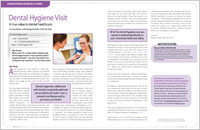
Dental Hygiene Visit
There’s a lot more going on at your regular dental hygiene visit than a feel-good polishing! Dental hygienists collaborate with dentists to provide optimum personalized oral health care to prevent oral disease and to promote your health… Read Article
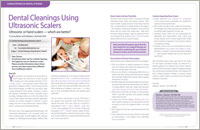
Dental Cleanings Using Ultrasonic Scalers
Rapidly changing technology has revolutionized periodontal therapy with the integration of power scaling techniques resulting in improved clinical outcomes, patient comfort, and reduced time and physical demands on clinicians… Read Article
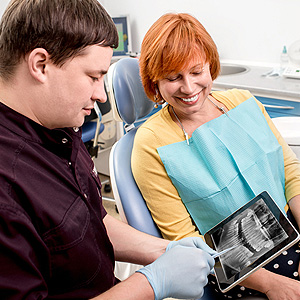
X-ray imaging has come a long way since films were bathed in developer and fixer and hung to dry. The fully digitized equipment at CenterCare, along with our computers, allows manipulation and examination of the x-ray image to give us insights we never had. Amazingly, while the precision has increased, the radiation has decreased! Our technology ensures that our Phoenix patients are exposed to minimal radiation, much less than the x-ray film used before.
At CenterCare we use small image format and panographic format as well as CBCT (Cone beam Computed Tomography) format, or CT 3-dimensional scanning. The diagnostic capabilities we have as a result are very extensive. The level of patient care has never been higher.
CT Scan
CBCT, or Dental Cone Beam Computed Tomography, is a very precise CT scan that gives us 3-dimensional images of teeth and jaws that have never been available before. The system used by CenterCare Dental Group has the lowest radiation and the most well-defined field of view in the industry. We use it routinely for all bone grafting and implant surgery. It has value in root canal treatment, wisdom tooth extractions and periodontal surgery as well. From these images we identify exact locations and dimensions of critical anatomical structures like nerve canals, sinus shapes and bone height. It is yet another way CenterCare brings technology to patient safety and quality of care.
Intraoral X-rays
Digital cameras are now small enough to swallow in a capsule and send photos from their passage through the intestine! At CenterCare we don’t need them that small, but we can still use the technology to capture precise pictures of conditions inside the mouth using an advanced micro camera designed for just that purpose.
Although we all look at least at the fronts of our mouths daily, taking a visual tour of the hard-to-see areas in the back of the mouth is an unusual adventure and usually good for a few surprises. Not only do CenterCare’s Phoenix patients get to take the tour, but the information it provides is stored forever in the digital files of each patient.

Oral cancer comprises 6% of all cancers and ranks 6th in risk. At CenterCare, the oral exam always includes a visual check for cancer.
CenterCare has added a cancer detection tool that is considered state of the art in non-biopsy cancer detection. It uses technology called bio-fluorescence. When light strikes any object, much of it is reflected, and this is most of what we see with our eyes. If that object absorbs the light energy it can re-emit it as a different wavelength. This is called fluorescence and has been developed for use in healthcare to identify abnormal tissue.
When light reflects off early cell changes in oral tissue there is no visible difference from normal tissue. With fluorescence, altered cells can be seen before they would be visible otherwise. It is not yet diagnostic of cancer. That would require a biopsy. It does, however, amount to early detection of change, and that could save a life.
This technology is a routine part of an oral exam at CenterCare in Phoenix.
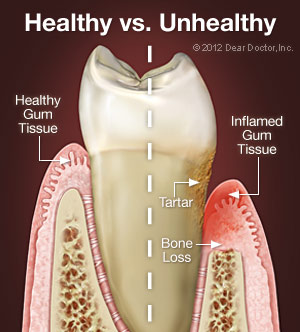
While you may think that some loss of teeth is inevitable with aging, it is actually possible for all of your teeth to last a lifetime. One of the ways you can achieve this goal is to avoid periodontal disease (“peri” – around; “odont” – tooth), which is caused by bacteria that attack the tissues around the teeth. Unfortunately, you may not even realize you have gum disease as the signs and symptoms are not always as apparent to you as they are to a dental professional.
Nearly all people who do not maintain good daily oral hygiene will develop gingivitis. If left untreated, this bacterial gum infection can progress from gingivitis (“gingival” – gum; “itis” – inflammation) to periodontitis, which results in bone loss around your teeth. As the bone tissue is lost, the gum tissues detach from the teeth and form little pockets that provide an even better place for bacteria to live — where your brush and floss can’t reach. As periodontal disease advances leading to more bone loss, tooth loss can result. Part of this has to do with genetics, as periodontal disease tends to run in families. The good news is that periodontal disease can be controlled, even at more advanced stages.
Signs and symptoms of periodontal disease
It’s important to understand that you can have periodontal disease with no obvious symptoms, especially if you are a smoker (nicotine reduces blood supply preventing bleeding and swelling of the gum tissues). Still, there are some important things to look for:
- Bleeding gums — Some people think that when their gums bleed, it simply means they’re brushing too hard. While brushing too hard is bad for the gums, it should not cause bleeding. Any bleeding of the gums should be considered a warning sign of gum disease.
- Bad breath — It’s very easy for plaque to collect in the spaces between the teeth, creating the perfect living conditions for bacteria that produce odorous, sulfur-containing compounds, resulting in bad breath.
- Redness or swelling of the gums — Inflammation of the gums is usually the first visible sign of periodontal disease.
- Receding gums — If you notice that your teeth look longer than they used to, it may be that your gum tissue has receded (away from the enamel), exposing some of your tooth roots.
- Sensitivity — If there is gum recession, the exposed roots may become sensitive to hot or cold.
- Periodontal abscess — Bacteria can become enclosed in a periodontal pocket and the area will fill with pus, becoming swollen and painful.
- Loose teeth — When periodontal disease results in bone loss, teeth can become loose or migrate. Tooth loss can result and may be accelerated if you are applying excessive biting forces from clenching or grinding your teeth.
Treatment options
All periodontal therapy starts with the evaluation of your oral hygiene techniques and instruction for improving them, followed by the mechanical removal of plaque and any calcified deposits (tartar or calculus) that are present on the root surfaces. This is accomplished with a cleaning technique known as scaling, root planing or debridement using hand instruments and/or ultrasonic (high frequency vibration) instruments. Locally applied antimicrobial products or antibiotics might also be recommended during various parts of periodontal treatment to assist in healing and pocket-depth reduction, hopefully eliminating the need for periodontal surgery. Sometimes surgical procedures may be necessary to remove the deep pockets that form between inflamed gum tissue and teeth. There are many different types of surgery to handle a variety of problems. And many times, combinations of procedures are used to attempt to reduce the number of surgeries as well as the cost of treatment.
Periodontal disease & your overall health
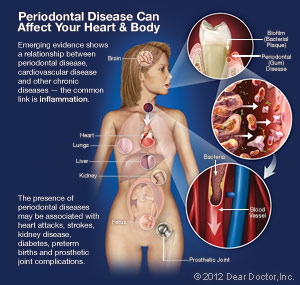
Periodontal disease starts in your mouth but has actually been linked to more serious conditions, such as cardio-vascular disease (CVD), diabetes and preterm births. Research has suggested two plausible mechanisms for how gum disease and these other serious medical concerns could be related: moderate to severe periodontal disease increases the level of systemic (bodily) inflammation — a characteristic of all chronic inflammatory diseases. Also, the same bacterial strains that are commonly found in periodontal pockets surrounding diseased teeth have been found in blood vessel plaques of individuals with CVD. Therefore, it may be helpful to reduce periodontal inflammation to reduce systemic inflammation.
Preventive strategies
The best way to prevent periodontal disease is to brush and floss your teeth effectively every day. Regular dental checkups and professional cleanings every 3 or 4 or 6 months are also an important part of maintaining periodontal health; the instruments and techniques used in these cleanings can reach into areas that your toothbrush and floss can’t.
It is also possible to detect early forms of gum disease by evaluating your gingival (gum) tissues, both visually and by examining their attachment levels to the teeth. And the health of your tooth-supporting bone can be assessed by taking dental radiographs (x-rays pictures).
There are other steps you can take: Eating right, reducing stress in your life, and giving up unhealthy habits like smoking will also help ensure that you keep your teeth for a lifetime.
https://www.mouthhealthy.org/en/az-topics/g/gum-disease
Related Articles
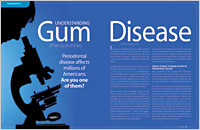
Understanding Gum (Periodontal) Disease
Have your gums ever bled when you brushed or flossed? This most commonly overlooked simple sign may be the start of a silent progressive disease leading to tooth loss. Learn what you can do to prevent this problem and keep your teeth for life… Read Article
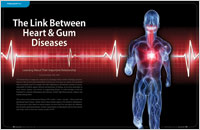
The Link Between Heart & Gum Diseases
Inflammation has emerged as a factor in the process of cardiovascular disease (CVD), which commonly results in heart attacks and strokes. While the precise role inflammation plays in causing chronic CVD remains an area of intense investigation, much more is now known. The good news is that, based on current research, we know that if we can reduce the inflammation caused by periodontal disease, we may reduce the risk for heart attacks and strokes… Read Article

Periodontal Plastic Surgery
Millions of Americans have some degree of gum recession — a loss of the tough, pink tissue that surrounds teeth. Receding gums can cause anything from minor tooth sensitivity to tooth loss in very severe cases. Fortunately, the field of periodontal plastic surgery has made enormous strides in devising techniques, including grafting, to deal with the problem of lost or damaged gum tissue… Read Article

